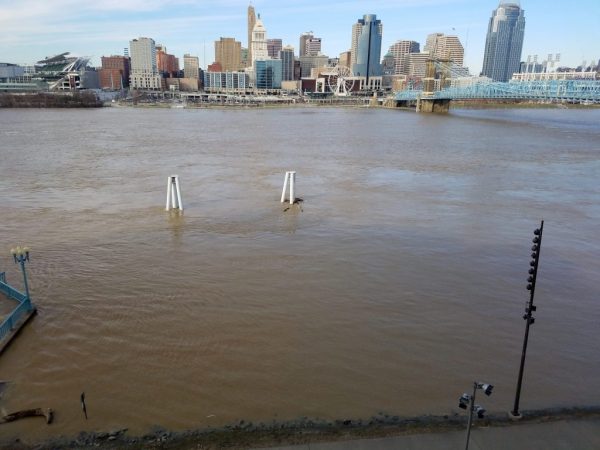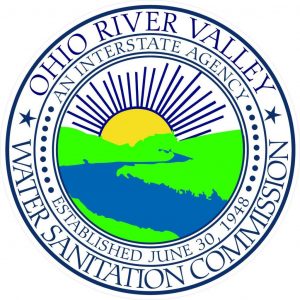- Like
- Digg
- Del
- Tumblr
- VKontakte
- Buffer
- Love This
- Odnoklassniki
- Meneame
- Blogger
- Amazon
- Yahoo Mail
- Gmail
- AOL
- Newsvine
- HackerNews
- Evernote
- MySpace
- Mail.ru
- Viadeo
- Line
- Comments
- Yummly
- SMS
- Viber
- Telegram
- Subscribe
- Skype
- Facebook Messenger
- Kakao
- LiveJournal
- Yammer
- Edgar
- Fintel
- Mix
- Instapaper
- Copy Link

The flooded, polluted Ohio River near the site of the February ORSANCO Commission meetings. Photo by Robin Blakeman.
What’s up with the Ohio River Pollution Control Standards?
That’s a question that has been plaguing me and OVEC volunteer Randi Pokladnik. That’s why we went to Cincinnati, OH, for the February 12 to 14 ORSANCO Technical Committee and Commission meetings. We met up with representatives from many of our allied environmental groups in the Ohio River region.
The meeting provided us some answers, and a new pollution control standards proposal.

The crowd at the meeting overwhelmingly wanted more protection from pollution, not less.
Many representatives from the allied groups gave public comments to the Commission relating their extreme concern over any decrease in Pollution Control Standards, and their hope that these standards will actually be increased in the near future.
The nutshell outcome of the Commission meetings is that there are still very serious concerns about pollution in the main-stem of the Ohio River; thus, the ORSANCO Commission has reinforced their commitment to maintaining the usage criteria for water quality in the Ohio River and we have a new proposal from the ORSANCO Commission to consider and comment on regarding their Pollution Control Standards (PCS).
You can read this new proposal and find out about informational webinars here.
You will also be able to get information about how to submit comments and/or attend public comment hearings on this web page.
In essence, this new proposal retains the current ORSANCO Pollution Control Standards, but allows the member states in the ORSANCO Compact to use alternative PCS criteria in their permitting processes, as long as the designated “uses” — as defined in the ORSANCO Compact — of the river are maintained. New language was added to require state permit writers to submit their permit information to ORSANCO staff for review, prior to full approval of those permits. Under the new proposal, these reviews will be key in terms of potential challenges to states issuing permits which could result in pollution discharges that could impair the Ohio in such a way that it is not possible to still use the water in a certain place for recreation, tap water sources, industrial uses, and biological/aquatic life forms (this is a summary of the designated uses that ORSANCO maintains).
A 45-day public comment period began on March 1 and ends on April 15, 2019. During this time period, you can take part in informational webinars on March 12 and March 14, as well as attend three public hearings, held in the evenings from 6-8 p.m., (consult this web page for specific locations) :
• Pittsburgh, PA – April 1
• Evansville, IN – April 4
• Cincinnati, OH – April 8
If you are concerned about Ohio River water quality, as we are, you are strongly encouraged to go to a hearing and/or submit a written comment by email, using PCS@orsanco.org or USPS:
ORSANCO
5735 Kellogg Ave.
Cincinnati, OH 45230
Here are some talking points you can use:
- Pre-dating the Clean Water Act, the states in the Compact took it into their own hands to protect the integrity of the Ohio River and made a commitment to protecting to special uses of the River. We believe that all states should adopt and implement ORSANCO’s PCS, but we accept this option as an interim measure because it preserves the PCS standards.
- This current PCS is acceptable under the condition that:
- ORSANCO works towards requiring all states to adopt and implement the PCS or equivalent.
- States are only allowed to deviate from PCS for good scientific reasons [or based on social and economic justification].
- Policies and procedures are developed to respond if a state proposes to deviate from PCS, i.e. that state needs to inform the other states, provide public notice of its intention to deviate from PCS and why, and allow for the public and other states to comment on the proposal.
- Policies and procedures are developed to continue to monitor for deviations from ORSANCO standards and are ready for implementation by the October commission meeting.
- ORSANCO should maintain the triennial review process, developing a report available to the public every 3 years to compare USEPA criteria and PCS with each state standards for all parameters.
- ORSANCO should continue to perform permit reviews, and seek funding for additional staffing in order to make sure such reviews can be done in as timely a manner as possible.
In addition, given the probable buildup of oil and gas along the OHIO, and the fact that these wells do not have to abide by any major environmental regulations, and the possibility of increased cumulative pollutants entering the River due to the current ORSANCO PCS proposal, we would strongly advocate for additional sampling sites being added to the current Organic Detection System, to allow for a better coverage, and earlier detection of spills and harmful pollution level increases.
OVEC will continue to follow this critical issue closely, so be certain you are signed up to receive our action alerts and blog digests.
If you have questions and/or want to get more involved by attending a public hearing, please contact me at robin@ohvec.org as soon as possible.











